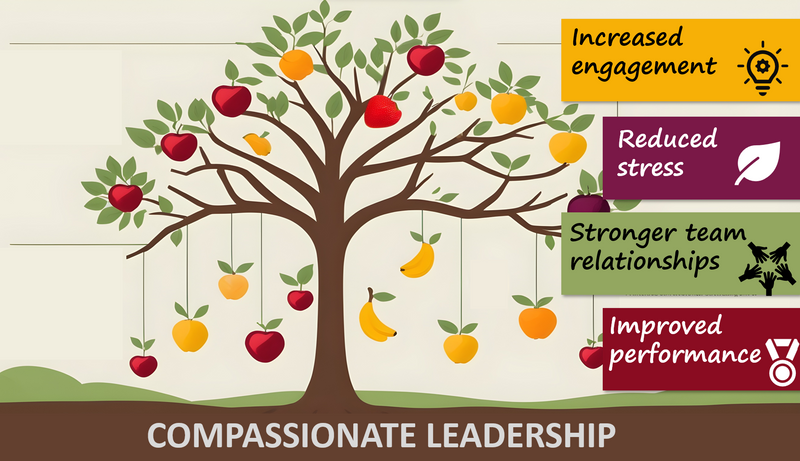Do you want to be a leader that people trust and respect?
 Photo by Riccardo Annandale on Unsplash
Photo by Riccardo Annandale on UnsplashCompassionate leadership is the key!
There are 5 qualities that will help you lead with compassion and gain a happier, more supportive, and more productive team.
What is Compassionate Leadership?
Compassionate leadership is the practice of using your head and heart to inspire and influence people so they can, in turn, inspire and influence others.
— Laurell Donnellan, founder of Compassionate Leaders Circle
Sounds good. But what does it actually mean?
 Compassionate leaders focus on understanding, caring about, and supporting their team members.
Compassionate leaders focus on understanding, caring about, and supporting their team members.
It is a leadership style based on creating a work environment where people feel valued, respected and empowered to do their best work.
And who wouldn't want to work in a place like that?
Benefits of a Compassionate Leadership Style
 Image created by the author using WePik. To hear an audio version of the information in the image above, click the play button on the audio player below:
Image created by the author using WePik. To hear an audio version of the information in the image above, click the play button on the audio player below:
Key Qualities of a Compassionate Leader
1. Empathy

Although empathy has always been a vital leadership skill, research suggests that, in recent years, it has become the single most important one.
To be a compassionate leader, you need to be able to put yourself in your team members' shoes and understand their perspectives. This creates trust and strengthens working relationships.
2. Active Listening

Compassionate leadership means giving a team your full attention and demonstrating a genuine interest in what they're saying.
This shows respect, but it also allows you to really understand the team's needs, concerns, and ideas.
3. Supportiveness

It's important to encourage and assist team members in achieving their goals and overcoming challenges.
Compassionate leaders provide guidance, resources, and feedback that will help a team succeed.
4. Accountability with Fairness

Compassionate leaders hold their team members (and themselves) accountable, but do it in a fair and respectful way.
Your focus should be on development and encouragement rather than on punishment.
5. Humility

Being able to acknowledge your own limitations and mistakes while always being open to learning from others is a crucial quality for a leader. But, of course, there needs to be a balance between humility and confidence.
As a compassionate leader, you need to be smart enough to know when you don't have all the answers and seek out different perspectives.
Put It into Practice
1. Empathy
A team member is struggling to meet a deadline. Compassionate leaders acknowledge their circumstances and situation, and offer support without judgment.
 Photo by Marcos Paulo Prado on Unsplash
Photo by Marcos Paulo Prado on Unsplash2. Active Listening
Someone who leads with compassion will avoid distractions when talking to their team. They will maintain eye contact and ask clarifying questions to fully grasp the team's opinions or concerns.
 Photo by Eric Mok on Unsplash
Photo by Eric Mok on Unsplash3. Supportiveness
Knowing when to offer mentorship, how to best delegate tasks, and remembering to always celebrate individual and team achievements are key to compassionate and supportive leadership.
 Photo by Scott Trento on Unsplash
Photo by Scott Trento on Unsplash4. Accountability with Fairness
A project has just been finished. A compassionate leader will give specific feedback on each team member's performance, and develop a plan for improvement. There's always room for improvement!
 Photo by Tingey Injury Law Firm on Unsplash
Photo by Tingey Injury Law Firm on Unsplash5. Humility
When a compassionate leader makes a mistake, they own up to it. They will also encourage open communication and welcome input from everyone on the team because they realize that the best ideas are not always their own.
 Photo by Joshua Earle on Unsplash
Photo by Joshua Earle on UnsplashPut It to the Test
 Photo by Annie Spratt on Unsplash
Photo by Annie Spratt on UnsplashA team member approaches you feeling overwhelmed by their workload. They haven't mentioned it before, but you think that they may be struggling personally, too.
How can you demonstrate compassion in this situation?

A. Offer them an immediate deadline extension.
B. Listen attentively and ask open-ended questions to understand their challenges.
C. Acknowledge their feelings and offer words of encouragement and support.
D. Delegate some of their tasks to other team members without asking.
Quiz
How can you demonstrate compassion in this situation? Choose all that apply:
Take Action
 Photo by Kid Circus on Unsplash
Photo by Kid Circus on UnsplashTo become a more compassionate leader:
Your feedback matters to us.
This Byte helped me better understand the topic.
